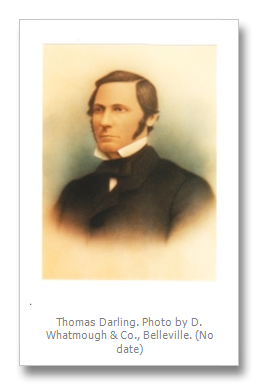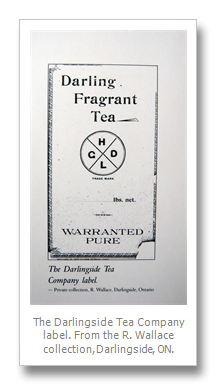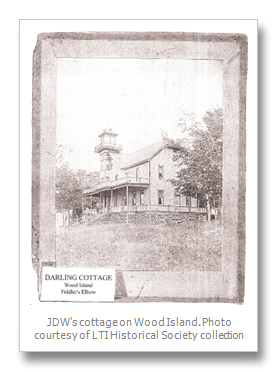The Darlingside store is located on the St. Lawrence River, east of the Thousand Island Bridge, on the Canadian shore. A familiar sight, it stands as a reminder of this once- busy spot and is a tribute to the family which played a significant role in the growth and development of the area.
By the 1830’s steamships started appearing on the St. Lawrence and they required a constant supply of cordwood for fuel, and cordwood depots sprung up at points along the river as farmers had a steady supply of wood from their farms. A depot was established between Buck’s Bay and the Palisades at the Lansdowne/Escott Township line by Gananoque’s McDonald family.The site was ideal as a rock ledge dropped off into very- deep water thus allowing the largest steamers to easily refuel. There is evidence that steamers were stopping there as early as 1837.
Thomas Darling, born in 1813 in Swinton, Berwickshire, Scotland came to Canada with his brother David and they worked for the McDonalds. After suffering a broken leg , he was sent to work at their wood depot, while he recovered. He eventually purchased the business and twenty acres of surrounding land and in 1845 he constructed a store on the riverbank where he sold farmers the goods they needed and they sold him wood.

A large fenced wood yard was built at the top of the hill where the parkette on the Parkway is today. The wood yard was in existence in the early 1900’s. The hill was the one obstacle to the success of the business as the wood had to be transported down the hill to the wharf for delivery, adding to its the cost. The farmers refused to deliver to the bottom of the hill so Darling had the wood stacked, carefully, at the wood yard. In 1875 and 1876, 6700 cords were received at the wood yard and 7201 cords of wood were sold from the wharf, a gain of 501 cords between the top and the bottom and there is evidence that wood was wheeled down the hill which took a great deal of effort. Barges also brought wood from Landon’s Bay and other points along the river.
The Darling Dock was once considered to be a village as it had a post office and a resident shoemaker. When the Grand Trunk Railway was being constructed, the ties for the line between Brockville and Kingston were unloaded at the wharf. Thomas also dealt in hides and potash for sale to markets in the United States, and abroad. He further expanded his property holdings and eventually Darling’s Wharf became known as Darlingside. Thomas married Janet Findlay in 1845 and had a family of ten children but only eight survived.
When Thomas Darling died in 1882, his widow continued to run the depot into the 1890’s. By that time coal was replacing wood as a fuel and the quality of the wood in the region had declined. Darling’s Wharf was the last cordwood depot to operate on the river and likely survived, longer than the others, because of the many services it supplied to the surrounding area.
Sons Thomas Jr. and JDW (John David William) continued the mercantile business and moved it to the village of Lansdowne. They sold the business in the early 1900’s and pursued other careers serving the local community as they were very- innovative entrepreneurs. By 1882 they had a private telephone line that ran from JDW’s office in Lansdowne to Darlingside and on to Carnegie’s store in Rockport. The line was later sold to the Lansdowne Rural Telephone Company. The Darlings dealt in cattle, cheese, coal, and they imported Percheron horses from France. They also provided a variety of legal services and JDW was the township clerk for forty years. Along with their sister Margaret they provided much of the mortgage money to farmers in the area to purchase their farms. They also made major investments in Canada’s west, particularly in Edmonton and Calgary where Thomas Jr. spent part of each year looking after their business interests.

JDW started a tea business in the 1870’s. His brother George did the travelling for him by horse and wagon, selling tea, door- to- door under the name of “Darling’s Fragrant Tea”. In 1893, George purchased the business from his brother and expanded it west to Bath, north to Plevna and into the Renfrew area and the Ottawa Valley. Tea was imported from Japan through a wholesale business in Montreal. George Darling used the store at Darlingside as his headquarters. Record books of his daily- tea sales, and customers, have been preserved. In 1894, George ordered 350 half chests of tea which were delivered by steamer to the wharf. Each chest weighed approximately 60 pounds so that would amount to ten tons of tea! He later had tea shipped directly to customers from Montreal and expanded sales into northern New York State. You could still buy tea from the store at the wharf up until the the early 1940’s.
Several of the family members owned islands in the region. Thomas Jr. owned Virgin Island at the mouth of the creek west of the Thousand Islands Bridge. JDW had a grand cottage on Wood Island , so named as it was used as a wood depot. It gradually fell into ruin and a family story says he eventually set fire to it.

The construction of the Canadian Thousand Islands Parkway (Scenic Highway) cut off access to the Darlingside store and the nearby house. The family demanded that a tunnel, big enough to accommodate a load of hay, be built as compensation. There were other families who also wished access to this new highway, but there were only two concessions. The Darlingside Tunnel and the cement bridle path above the highway at Jones’ Creek built for the Siftons who paid for part of the construction. The Darlingside tunnel cannot be seen from the highway and is a little-known aspect of the Parkway. In addition to the Store, the Darling family also owned the mainland site of today’s Thousand Islands Bridge. They had plans drawn up for a cottage subdivision on the property which now forms part of the Ivy Lea Provincial Park, located to the west of the bridge.
Many of the Darling family members remained unmarried and made their home in the house at the wharf. The last to live there was George. After his death in 1945 his youngest sister Ida, who was married to Dr. Wesley Wallace (Wallace Island family), continued to use Darlingside as a summer home as did her son Robert Wallace. They travelled every year from Brooklyn, New York, to summer in the islands. After Robert’s death, in the early 1990’s, his children sold the property. So, after 150 years the property was no longer owned by the original family.
Darlingside is indeed one of the most beautiful spots along the river.
By Alan Lindsay
The Darlingside Archives are housed at Queen's University Archives and with the Leeds and Thousand Islands Historical Soceity.
Alan Lindsay is a retired teacher who grew up in the Gananoque area. He can trace his roots to 1789 and I believe that he is not, as he claims, an "amateur" historian and genealogist, and we are most thankful for his interest in the early families of the Thousand Islands area. He is a popular speaker, a long-time member of the Leeds and Thousand Islands Historical Society, and writer.
Editor: The Leeds and Thousand Islands Historical Society is dedicated to preserving the history of the former townships of Front and Rear of Leeds and Lansdowne and Escott. The Society has a large collection of artifacts, paper material, and pictures. Their excellent website is appreciated by historians and their newsletter - http://www.ltihistoricalsociety.org/newsletters.html - is one of the best in the region. They can be contacted via the website or by writing to. LTI Historical Society, P.O. Box 332, Lansdowne, ON K0E 1L0.